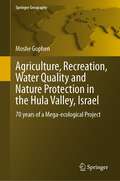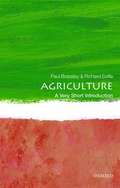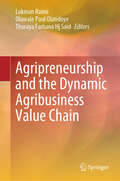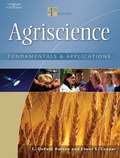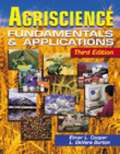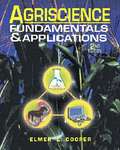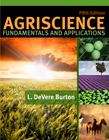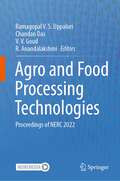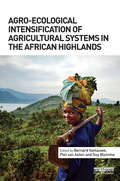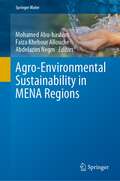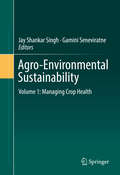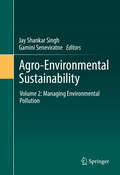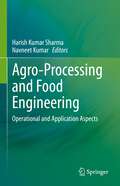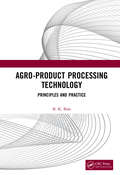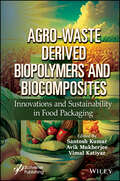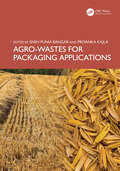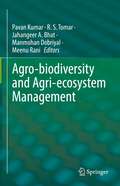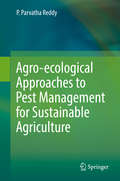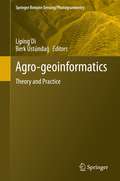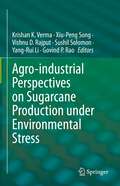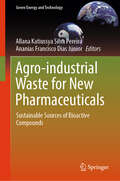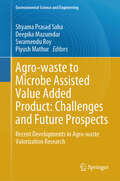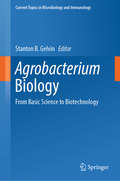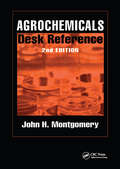- Table View
- List View
Agriculture, Recreation, Water Quality and Nature Protection in the Hula Valley, Israel: 70 years of a Mega-ecological Project (Springer Geography)
by Moshe GophenThe anxious search for agricultural income resources, and assurance of the national water supply in the northern newly created state of Israel initiated the national project of the Hula Drainage. The implementation of this project was accompanied as of today by research and monitoring of the ecological trait aimed at crop harvest improvement in the Hula valley and prevention of water quality deterioration in Lake Kinneret. Forty years later a reclamation project to improve the peat soil property and renovate the hydrological system was carried out. This book documents the scientific research carried out during this mega-ecological project. Several issues of the ecological renovation and its impact on the Hula valley management and water quality in lake Kinneret are presented in this book. The advantage and contribution of a newly created shallow lake Agmon-Hula to nutrient dynamics, and hydrological control, accompanied by avian presence, (among others, Cranes, Storks, Pelicans, Flamingoes) and plants renewal which enhanced, tourism; potential impact of nitrogen and sulfate migration from the Hula valley on the Kinneret water quality; the role of climate change on the ecology of the Hula Valley and the Kinneret nutrient availabilities and phytoplankton community; the subterranean migration of water and nutrients and water loss. Further proposals for future development are under consideration. This book presents a comprehensive practical management implementation of a long-term ecological project. Results of scientific and monitoring research which followed the project implementation benefit the international and national communities.
Agriculture: A Very Short Introduction (Very Short Introductions Series)
by Paul Brassley Richard SoffeAgriculture, one of the oldest human occupations, is practised all over the world, using techniques ranging from the profoundly traditional to the most scientifically advanced. How many of us understand what is happening in the fields and think about the origins of the food in our trolley? In this Very Short Introduction, Paul Brassley and Richard Soffe explain what farmers do and why they do it. Beginning with the most basic resource, the soil, they show why it is important, and how farmers can increase its productivity, before turning to the plants and animals that grow on it, and tracing the connections between their biology and the various ways in which farmers work with them. The authors conclude by looking at some of the controversial issues facing contemporary agriculture: its sustainability; its impact on wildlife and landscape; issues of animal welfare; and the affect of climate change and the development of genetically modified organisms on farmers.
Agripreneurship and the Dynamic Agribusiness Value Chain
by Lukman Raimi Olawale Paul Olatidoye Thuraya Farhana Hj SaidThis book provides an insightful exploration of agribusiness entrepreneurship in the dynamic landscape of the global economy. Targeted at agribusiness researchers, agricultural scientists, finance professionals, and consultants, the thematic focus encompasses agricultural and business entrepreneurship, production and consumption dynamics, ethical considerations, impact investments, and disruptive technologies such as Bitcoin, digital ventures, cryptocurrency, and blockchain. Addressing the principles governing innovative business models, the text delves into the multifaceted realm of entrepreneurship in agriculture, with a specific emphasis on Sustainable Development Goals (SDGs) and the integration of science, technology, engineering, and mathematics (STEM) in agribusiness. The book underscores the pivotal role of agripreneurs in driving agricultural activities, employing mechanization, irrigation, and modern farming technologies to augment production. It navigates the complexities of rural entrepreneurial activity, considering factors like location, natural resources, social capital, and information technologies. Furthermore, the book investigates the necessity for an entrepreneurial culture in agriculture, citing its potential to alleviate challenges, create employment opportunities, curb rural-to-urban migration, and enhance national income. Through a pragmatic lens, it explores the educational processes required for farmers to develop entrepreneurial and organizational skills, emphasizing the significance of such skills in fostering sustainable development. A comprehensive examination of entrepreneurship in agriculture, this book stands as an indispensable resource for those seeking a nuanced understanding of agribusiness dynamics, the integration of innovative technologies, and the role of entrepreneurship in shaping the future of agriculture.
Agriscience: Fundamentals & Applications
by Elmer L. Cooper L. Devere BurtonAgriscience Fundamentals and Applications is the most effective book available for introducing agricultural education. It addresses the full spectrum of the agricultural industry and introduces science as the basis for higher productivity and for the safest food system in the world. Readers also gain knowledge about agricultural careers and opportunities through the Agri-Profile feature. The authors successfully convey the principles of integrating science into the agricultural curriculum, and they educate readers about accessing related material on the Internet and about National FFA programs related to agriscience and technology. Color photos and illustrations, discussions of recent technological advances and Hot Topic inserts are just some of the many tools used to help the reader comprehend the wealth of material contained in this introduction to agriscience.
Agriscience: Fundamentals And Applications (3rd edition)
by Elmer L. Cooper L. Devere BurtonThis third edition of "Agriscience: Fundamentals & Applications," addresses the basic levels of modern agriscience concepts using language and examples designed to meet the needs of beginning students interested in natural science careers. The text integrates broadened principles of agriculture through all the major science areas, and adds many new applications of science, technology, math, agriculture, natural resources and the environment. New full-color photographs and illustrations have been added for visual enhancement, as well as internet icons to help students explore agriscience topics beyond the boundaries of the text. The unit profiles and student activities provide instructors with innovative ways to teach modern agriscience concepts, as this book contains invaluable resources for introductory agriscience curriculums.
Agriscience: Fundamentals and Applications
by Elmer L. CooperPatterned after FFA-endorsed curricula, this best-selling full-color text integrates basic biological and technological concepts with principles of production agriculture. It carefully takes students through all major science areas from plant and animal sciences, to food science, to environmental technology. The Second Edition features several new Agri-profiles of hi-tech agricultural careers, as well as the latest information on integrated pest management, agribusiness, and natural resource management. Stocked with pedagogical aids, such as performance-based objectives, terms-to-know, chapter-ending reviews, and objective, essay, and review questions, as well as a complete supplement package, this edition provides the tools needed to plan and implement a successful introductory Agriscience program. (plant and animal science, science of living things, biotechnology, natural resource management, hydroponics management)
Agriscience: Fundamentals and Applications
by L. Devere BurtonAgriscience Fundamentals and Applications, 5th edition provides a broad-spectrum overview of the agricultural industry and the industry-based sciences, including basic principles of science as they apply to plants, animals, soils and foods, for high school students. Each chapter includes visual aids such as color photos, sketches, diagrams, and tables. Agriscience Fundamentals and Applications, 5th edition, also identifies chapter objectives, evaluation materials, suggested class activities, key terms, and internet key words to guide student's in-depth study.
Agritech: Thermal and Non-Thermal Processing
by Nick Serpone Satoshi Horikoshi Graham Brodie Koichi TakakiThis book describes innovative agricultural methods using thermal and non-thermal microwave or plasma energies. Humans that were nomadic in the past can now stably obtain food by developing agriculture. Cities were formed as a result of remarkable development. Later, chemicals were introduced to agriculture to stabilize the food supply further. Natural products were initially used, but various artificial compounds have been developed for agriculture since the 1900s. To further improve crop productivity and diversification, gene recombination (genetic engineering) using biotechnology has progressed in recent years and continues to develop further. However, these technologies contain pesticide residues and pose safety risks. The innovative new agriculture explained in this book is based on the use of microwaves and plasma that do not rely on chemicals and genetic modification. This is one of the first books focusing on the agricultural usage of microwaves. In addition, it is a technical book that incorporates plasma into agriculture from this perspective. The book covers microwaves and plasmas, which are completely different fields. Thus, it will be attractive to many readers who want to acquaint themselves with these alternative technologies and implement them. This book will be useful to a broad audience including researchers and technicians at Universities and practitioners in industries. It is made accessible to readers across different fields by including abundant figures and by limiting the use of equations to the possible extent.
Agro and Food Processing Technologies: Proceedings of NERC 2022
by Chandan Das Ramagopal V. S. Uppaluri V. V. Goud R. AnandalakshmiThis book focuses on sustainable agro and food technologies for the northeast region of India and provides holistic insights into relevant and contextual scientific and technical advances in the agro-food sector. Agriculture is an important livelihood avenue for many residents of northeast India. Low-cost scientific and technological intervention can transform agricultural farm produces and generate farm waste into processed value-added products. This book will serve as a valuable resource to further enhance the linkage between managerial aspects and technological knowledge systems in this field and eventually catalyse potential knowledge frameworks for the long-term prosperity and sustainability of bio-diversity-rich North-east India. It emphasizes the research culture that needs to be adopted for the most relevant food and agro-processing technologies for the sustainable growth and prosperity of the region.
Agro-Ecological Intensification of Agricultural Systems in the African Highlands
by Guy Blomme Piet Van Asten Bernard VanlauweThere is an urgent need to increase agricultural productivity in sub-Saharan Africa in a sustainable and economically-viable manner. Transforming risk-averse smallholders into business-oriented producers that invest in producing surplus food for sale provides a formidable challenge, both from a technological and socio-political perspective. This book addresses the issue of agricultural intensification in the humid highland areas of Africa – regions with relatively good agricultural potential, but where the scarce land resources are increasingly under pressure from the growing population and from climate change. In addition to introductory and synthesis chapters, the book focuses on four themes: system components required for agricultural intensification; the integration of components at the system level; drivers for adoption of technologies towards intensification; and the dissemination of complex knowledge. It provides case studies of improved crop and soil management for staple crops such as cassava and bananas, as well as examples of how the livelihoods of rural people can be improved. The book provides a valuable resource for researchers, development actors, students and policy makers in agricultural systems and economics and in international development. It highlights and addresses key challenges and opportunities that exist for sustainable agricultural intensification in the humid highlands of sub-Saharan Africa.
Agro-Environmental Sustainability in MENA Regions (Springer Water)
by Mohamed Abu-Hashim Abdelazim Negm Faiza Khebour AlloucheThis book focuses on the status quo and the latest information on the water-soil-agriculture nexus in the MENA countries. It presents several case studies and applications from e.g. Morocco, Algeria, Tunisia, Egypt and Jordan, while also sharing and discussing the latest findings. The content includes a range of agriculture-related topics that focus on: water resources management, impacts of climate change, and wastewater treatment for reuse in agriculture sectors; in addition, sustainable approaches to agricultural-based industry, organic crop production, crop water requirements, and soil environment are discussed in an updated and comprehensive review. In turn, the book discusses the applications of GIS and remote sensing as a new technology for better agriculture management, as well as its use in Egypt as a representative country. In closing, it considers the implementation of an environmental information system in data-scarce MENA countries from the standpoint of the water-food nexus, and addresses the question of climate justice in the MENA region. Exploring various dimensions of MENA country-based case studies on achieving sustainable agriculture, the book offers an invaluable source of topical information for agricultural sustainability-related stakeholders in the region, researchers and graduate students alike.
Agro-Environmental Sustainability: Volume 1: Managing Crop Health
by Gamini Seneviratne Jay Shankar SinghThis two-volume work is a testament to the increasing interest in the role of microbes in sustainable agriculture and food security. Advances in microbial technologies are explored in chapters dealing with topics such as carbon sequestration, soil fertility management, sustainable crop production, and microbial signaling networks. Volume I is a collection of research findings that invites readers to examine the application of microbes in reinstating degraded ecosystems and also in establishing sustainable croplands. Highly readable entries attempt to close the knowledge gap between soil microbial associations and sustainable agriculture. An increase in the global population with changing climate is leading to environments of various abiotic and biotic stresses for agricultural crops. It therefore becomes important to identify the techniques to improve soil fertility and function using different microbial groups such as actinobacteria, microalgae, fluorescent pseudomonads and cyanobacterial systems. These are examined in this volume in greater detail. This work is a significant contribution to research in this increasingly important discipline, and will appeal to researchers in microbiology, agriculture, environmental sciences, and soil and crop sciences.
Agro-Environmental Sustainability: Volume 2: Managing Environmental Pollution
by Gamini Seneviratne Jay Shankar SinghThis two-volume work is a testament to the increasing interest in the role of microbes in sustainable agriculture and food security. Advances in microbial technologies are explored in chapters dealing with topics such as plant-microbe interactions, rhizoremediation and cyanoremediation, and bio-immobilization. Volume II is a collection of research findings that invites readers to examine the application of microbes in pollution reduction, decontamination of agro- and aquatic ecosystems, and remediation of various toxic compounds. Highly readable entries attempt to close the knowledge gap between soil microbial associations and sustainable agriculture. Traditional agricultural management techniques have relied heavily on application of chemical fertilizers and pesticides; and recent land use change practices have led to over exploitation of natural resources. Strategies outlined here simplify a complicated picture of the way microbial communities can improve the quality of environment and eliminate food scarcity in the coming generations. This work is a significant contribution to research in this increasingly important discipline of soil sciences, and will appeal to researchers in microbiology, agriculture, environmental sciences, and soil and crop sciences.
Agro-Processing and Food Engineering: Operational and Application Aspects
by Harish Kumar Sharma Navneet KumarThis textbook highlights the engineering fundamentals and processing aspects of agricultural produce and covers important aspects of agro-processing and food engineering in one place. The chapters cover material handling, drying, size reduction process, mixing and forming, cleaning and separation, storage, and processing of cereals, pulses, oilseeds, fruit and vegetables, and their products. The book’s contents are systematically designed to provide a balanced overview of agro-processing techniques from the basic concepts to the case study, handling of the materials, and different unit operations. The systematic and simple elaboration of scientific aspects will make it unique and help to develop skills in the field. Many illustrations in form of diagrams/charts/pictures provide a clear understanding. Solved numerical problems, which are given in the chapters, will provide students clarity in conceptualizing the basics. The book covers the syllabus related to agro-processing and food engineering at the undergraduate and postgraduate level in various universities, agricultural universities, allied institutes, and colleges across the globe. It will be extremely beneficial to students as it covers the most important and relevant topics, which are hardly covered in any other single compilation and published textbooks. It would be a good textbook for universities, agricultural universities, institutes, and colleges running courses in agriculture, horticulture, postharvest technology, process and food engineering, food engineering, food engineering and technology, food technology, food science, and food and nutrition.
Agro-Product Processing Technology: Principles and Practice
by B K BalaGlobal food security is a challenging issue. Meeting the food and nutritional requirements of the world has become an issue for national policymakers and is of public concern. There is a need to enhance agricultural production, as well as, to reduce postharvest loss, improve the quality of processed products, and add value to products to make more quality food available. Agro-product processing technology plays a major role to reduce post-harvest losses, improve the quality of processed products, and add value to the products. It also generates employment and ultimately contributes to food security. Features: Covers a wide spectrum of agro-product processing technology Explains the principles and practices of agro-product processing technology with many worked examples to quickly teach the basic principles through examples Contains examples from different operations on current problems to show the wide applications of the principles of agro-product technology Includes process control and emerging technologies in agro-product processing such as energy and exergy analysis, neural network modeling, and CFD modeling This book deals with physical and thermal properties, cleaning and sorting, drying and storage, parboiling and milling, by-product utilization, heating and cooling, refrigerated cooling, and cold storage. The most unique feature of this book is the machine vision for grading fruits, process control and materials handling, and emerging technologies such as neural network, finite element, CFD, and genetic algorithm.
Agro-Waste Derived Biopolymers and Biocomposites: Innovations and Sustainability in Food Packaging
by Santosh Kumar Vimal Katiyar Avik MukherjeeAGRO-WASTE DERIVED BIOPOLYMERS AND BIOCOMPOSITES This comprehensive book describes the fundamental principles and major advancements in the utilization of agro-waste for deriving biopolymers, and their applications to fabricate composite, nanocomposite, and hybrid food packaging films and coatings. The book serves as a complete, systematic, comprehensive account of the contemporary developments in the area of novel and environment-friendly valorization of agro- and food wastes into value-added products like biodegradable polymer and active functional agents for food packaging applications. It also describes the hurdles and challenges in the commercialization of these novel biopolymer-based materials, including their composites, their applications, safety, and legal ramifications. This book consists of fifteen chapters covering different aspects of agro- and food waste utilization, the development of biodegradable polymers, and their composites for sustainable food packaging applications. The first thirteen chapters detail the processing of various agro- and food wastes of plant and animal origin to synthesize different biopolymers, such as starch, cellulose, chitosan, silk proteins, pectin, etc., and their applications for the fabrication of sustainable food packaging materials and composites that are attractive alternatives to synthetic plastic packaging. These chapters also summarize the effectiveness of these biopolymers and their composites in developing active films and edible coatings for shelf-life extension and preservation of perishable foods. A chapter is devoted to issues of biodegradability, including analyses of various biodegradation reactions, such as depolymerization, mineralization, biochemical, and abiotic degradation both in soil and aquatic environments. The book concludes with a chapter addressing the concerns associated with the possible migration of components or additives from these biodegradable packaging into packaged food items. Audience The primary audience for this book is researchers, scientists, and engineers working in food science and technology, food engineering and technology, food biotechnology, sustainable food packaging, etc. Additionally, food entrepreneurs and associated businesses, such as the packaging and coatings industries, will also have a keen interest in the book.
Agro-Wastes for Packaging Applications
by Sneh Punia Bangar Priyanka KajlaFood and agricultural waste is a huge global issue that has detrimental effects on society, the economy, and the environment. Plant leaves, stems, roots and peels (outer leaves and stems) are among the wastes and by-products from agriculture and the food business, along with residues from oil production, fruit and vegetable peels, and seeds. High concentrations of dietary fiber, phytochemicals, cellulose, and hemicellulose are typically found in these residues. As the next environmentally conscious step of waste valorization, research from recent years has demonstrated that employing organic ingredients/biodegradable fibers generated from waste and by-products in the food packaging business may be an efficient strategy to reduce the quantity of food waste and by-products. In recent years, there has been a lot of interest in finding alternative polymer materials as high-value novel packaging materials through the valorization of agricultural waste. Thus, utilizing agricultural wastes and by-products as raw materials for food packaging could help cut down on the amount of waste produced.Agro-Wastes for Packaging Applications provides an update on the strategies for valuing agricultural waste and how these might be used in packaging. It also includes recent research on these approaches and presents an innovative strategy for developing sustainable, green, and biodegradable packaging options. A detailed overview of the packaging application of valorized agricultural waste materials is discussed, and concept clarification is achieved using flowcharts and figures supported by the latest research investigations. These agricultural leftovers are abundant sources of polysaccharides, such as cellulose, hemicellulose, and lignin, which can be processed further utilizing various physicochemical techniques and other unconventional techniques to create nanocellulose fibers or crystals. The main goal of this book is to provide food experts and the general public with superior, environmentally friendly, sustainable packaging materials that can be used in place of plastic polymers.Key Features Contains abundant information on advanced valorization techniques for different types of agricultural wastes Provides information on possible applications of component/constituents obtained by the valorization Discusses the impact of the incorporation of these valorized components in different packaging systems Reviews the legal standards and future trends in the commercialization of these derived polymers in food packaging industries
Agro-biodiversity and Agri-ecosystem Management
by Pavan Kumar Meenu Rani Jahangeer A. Bhat R. S. Tomar Manmohan DobriyalThis edited book collates latest findings in the field of agro-biodiversity and agri-ecosystem management across the globe through selected case studies. The primary aim of the book is to cover agro-biodiversity and agri-ecosystem advancements in the field of agricultural resource management. The book explores a range of technologies that support sustainable use of resources and facilities, such as Natural Resource Management (NRM), Resource Conservation Technologies (RCTs), Integrated Farming System (IFS), Integrated Crop Management (ICM), Integrated Nutrient Management (INM), use of solar energy, promotion of agro-ecological zone specific agricultural production, application of climate resilient technologies, secondary agricultural practices and post-harvest technologies. Agro-biodiversity and agri-ecosystem not only contributes to overall growth of the economy but also reduces poverty by providing employment and food security to the majority of the population in the continent and thus it is the most inclusive growth sectors of the economy of Asian and African countries. The book is relevant for researchers and policy makes in the field of agriculture, food system research, ecology, agricultural diversification, resource management etc.
Agro-ecological Approaches to Pest Management for Sustainable Agriculture
by P. Parvatha ReddyThis book outlines a new paradigm, "Agro-ecological Intensification of Crop Protection", which reduces negative impacts on the environment and enhances the provision of ecosystem services. It discusses the use of ecologically based management strategies to increase the sustainability of agricultural production while reducing off-site consequences, highlighting the underlying principles and outlining some of the key management practices and technologies required to implement agro-ecological pest management. It also comprehensively explores important topics like stimulo-deterrent diversion strategy, precision agriculture, plant breeding, nutrient management, habitat management, cultural approaches, cultivar mixtures/multiline cultivars, crop rotation, crop residue management, crop diversity, cover crops, conservation tillage, biofumigation, agro-forestry, and addition of organic matter. This timely book promotes the rapid implementation of this technology in farming community around the globe. It is a valuable resource for the scientific community involved in teaching, research and extension activities related to agro-ecological pest management as well as policymakers and practicing farmers. It can also be used for teaching post-graduate courses.
Agro-geoinformatics: Theory and Practice (Springer Remote Sensing/Photogrammetry)
by Liping Di Berk ÜstündağThis volume collects and presents the fundamentals, tools, and processes of utilizing geospatial information technologies to process remotely sensed data for use in agricultural monitoring and management. The issues related to handling digital agro-geoinformation, such as collecting (including field visits and remote sensing), processing, storing, archiving, preservation, retrieving, transmitting, accessing, visualization, analyzing, synthesizing, presenting, and disseminating agro-geoinformation have never before been systematically documented in one volume. The book is edited by International Conference on Agro-Geoinformatics organizers Dr. Liping Di (George Mason University), who coined the term “Agro-Geoinformatics” in 2012, and Dr. Berk Üstündağ (Istanbul Technical University) and are uniquely positioned to curate and edit this foundational text.The book is composed of eighteen chapters that can each stand alone but also build on each other to give the reader a comprehensive understanding of agro-geoinformatics and what the tools and processes that compose the field can accomplish. Topics covered include land parcel identification, image processing in agricultural observation systems, databasing and managing agricultural data, crop status monitoring, moisture and evapotranspiration assessment, flood damage monitoring, agricultural decision support systems and more.
Agro-industrial Perspectives on Sugarcane Production under Environmental Stress
by Vishnu D. Rajput Krishan K. Verma Xiu-Peng Song Sushil Solomon Yang-Rui Li Govind P. RaoThis edited volume focuses on the core aspects of sugarcane production-management under stressful environments as well as innovative strategies for augmenting crop growth & productivity through intrinsic and extrinsic manipulations. The various chapters aim at bringing out comprehensive and advance information on different aspects of sugarcane cultivation under stress environments and impact of climate change on the sustainability of sugarcane production. The book encompasses information about crop production management, physiological & nutritional requirements, ratooning, ripening and post-harvest losses management. It also delineates various technologies that support the continued use and improvement of sugarcane as renewable source of food, fiber and bio-energy. The manipulations at cellular and molecular levels, molecular breeding approaches and post-harvest technologies are also included. The area under sugarcane cultivation is gradually increasing because of its diversification potential. The high productivity and biomass of the cane crop also makes it a key source for use as bio-energy crop and a promising raw material for bio-based agro-industries. However, poor crop & biomass productivity due to abiotic stress is the foremost constraint in its future commercial exploitation as sustainable feed-stock for bio-based industries. It is therefore imperative to understand the cellular-molecular modulation responsible to productivity barrier under specific stress situation(s) for better sugarcane quality and quantum under field condition. Some of these innovative approaches are delineated in this book. This book is of interest to progressive sugarcane growers, millers, industrial entrepreneurs, sugarcane scientists, cane development and extension officers, sugar industry managers and valuable source of reference worldwide.
Agro-industrial Waste for New Pharmaceuticals: Sustainable Sources of Bioactive Compounds (Green Energy and Technology)
by Allana Katiussya Silva Pereira Ananias Francisco Dias JúniorThis book is written to foster discussions on the valorization of agro-industrial waste as a raw material for bioactive compounds that can assist in disease containment, the protection of soil resources, and consequently, human health. The agro-industry encompasses a broad spectrum of activities focused on transforming raw materials from agriculture, livestock, aquaculture, and forestry. In addition to producing a diverse range of goods, these processes generate substantial amounts of residual biomass from various cultivation and processing systems. In this context, the intensification of climate change and the overexploitation of natural resources have been major drivers of emerging infectious diseases. A recent and impactful example is SARS-CoV-2, which escalated into a global pandemic with severe mortality rates. Additionally, Latin America has experienced a sharp rise in dengue cases, prompting the Pan American Health Organization to issue an epidemiological alert due to the increasing incidence of arboviruses across the region. Given the need to explore possibilities for valuing and utilizing agro-industrial waste, this book presents the potential of this material in the context of human health. The authors present a comprehensive review of recent research on pyroligneous liquid as a rich source of bioactive compounds, alongside the use of biochar and bone char in water treatment and herbicide immobilization in soil. Additionally, the book provides an in-depth analysis of methodologies for extracting bioactive compounds from &“açaí&” (Euterpe oleracea and E. precatoria) waste, highlighting its potential for high-value applications. In this way, the book highlights the challenges and opportunities to transform these materials into beneficial resources, both for the environment and for society, contributing to the advancement of public health and environmental conservation in the context of climate change.
Agro-waste to Microbe Assisted Value Added Product: Recent Developments in Agro-waste Valorization Research (Environmental Science and Engineering)
by Swarnendu Roy Piyush Mathur Shyama Prasad Saha Deepika MazumdarThis book mainly focuses on the recent trends and sustainability challenges in the valorization of agro-wastes, emphasizing the role of microbial biotechnology. Processing of various kinds of agro-wastes such as lignocellulosic materials, food industry wastes, dairy wastes, etc., into several bioactive compounds, enzymes, biofuels, biogas, biofertilizers, nutraceuticals, nanoparticles, etc., will be discussed elaborately in more detail. This book investigates the theoretical and practical aspects of modern research regarding the valorization of agro-wastes through microbial technology. Moreover, the role of valorization research in circular bio-economy will also be addressed in this book.
Agrobacterium Biology: From Basic Science to Biotechnology (Current Topics in Microbiology and Immunology #418)
by Stanton B. GelvinThis volume reviews various facets of Agrobacterium biology, from modern aspects of taxonomy and bacterial ecology to pathogenesis, bacterial cell biology, plant and fungal transformation, natural transgenics, and biotechnology. Agrobacterium-mediated transformation is the most extensively utilized platform for generating transgenic plants, but modern biotechnology applications derive from more than 40 years of intensive basic scientific research. Many of the biological principles established by this research have served as models for other bacteria, including human and animal pathogens. Written by leading experts and highlighting recent advances, this volume serves both as an introduction to Agrobacterium biology for students as well as a more comprehensive text for research scientists.
Agrochemicals Desk Reference
by John H. MontgomeryThe Agrochemicals Desk Reference is a revised volume inspired by the growing number of research publications and continued interest in the fate, transport, and remediation of hazardous substances. Much data has been added to this edition, reflecting the wealth of literature in the field. Featured are environmental and physical/chemical data on more than 200 compounds, including pesticides, herbicides, and fungicides. All compounds are listed in alphabetical order, making it easy to find the data you need. The text is fully indexed by CAS number, RTECS number, empirical number, and synonyms.
